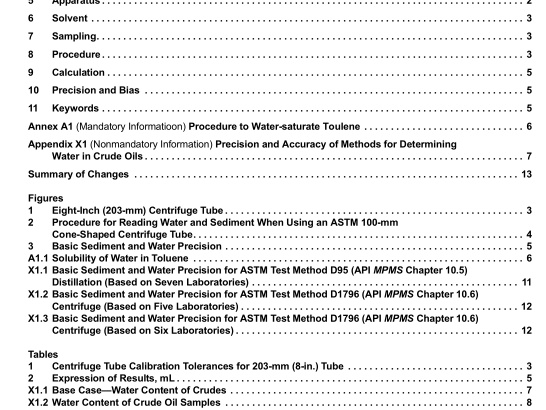API MPMS 10.3:2013 pdf free download.Manual of Petroleum Measurement Standards Chapter 10.3 Standard Test Method for Water and Sediment in Crude Oil by the Centrifuge Method (Laboratory Procedure)
6.2 Demulsifier—A demulsifier should be used to promote the separation of water from the sample and to prevent its clinging to the walls of the centrifuge tube. The recommended stock solution is 25 % demulsifier to 75 % toluene. For some crude oils a different ratio of demulsifier to toluene may be required. Demulsifiers used in the concentration and quantity recommended will not add to the water and sediment volume determined. The solution must be stored in a dark bottle that is tightly closed.
7. Sampling
7.1 Sampling is defined as all steps required to obtain an aliquot ofthe contents ofany pipe, tank, or other system and to place the sample into the laboratory test container.
7.2 Only representative samples obtained as specified in Practices D4057 (API MPMS Chapter 8.1) and Practice D4177 (API MPMS Chapter 8.2) shall be used for this test method. 7.3 Sample Mixing—is typically required to obtain a test portion representative of the bulk sample to be tested, but precautions shall be taken to maintain the integrity of the sample during this operation. Mixing of volatile crude petro- leum containing water or sediments, or both, may result in the loss oflight components. Additional information on the mixing and handling of liquid samples can be found in Practice D5854 (API MPMS Chapter 8.3).
8. Procedure
8.1 Fill each of two centrifuge tubes (5.2) to the 50-mL mark with sample directly from the sample container. Using a pipet or other suitable volume transfer device (see 5.4), add 50 6 0.05 mL of toluene, which has been water saturated at 60°C (140°F) or 71°C (160°F) (see 5.3). Read the top of the meniscus at both the 50 and 100-mL marks. Add 0.2 mL of demulsifier solution (6.2) to each tube, using a 0.2-mL pipet or other suitable volume transfer device, such as an automatic pipettor. Stopper the tube tightly and invert the tubes ten times to ensure that the oil and solvent are uniformly mixed.
8.2 In the case where the crude oil is very viscous and mixing ofthe solvent with the oil would be difficult, the solvent may be added to the centrifuge tube first to facilitate mixing. Take care to not fill the centrifuge tube past the 100-mL mark with the sample.
8.3 Loosen the stoppers slightly and immerse the tubes to the 100-mL mark for at least 15 min in the bath maintained at 60 6 3°C (140 6 5°F) (see 5.3). Secure the stoppers and again invert the tubes ten times to ensure uniform mixing of oil and solvent. (Warning—The vapor pressure at 60°C (140°F) is approximately double that at 40°C (104°F).)
8.4 Place the tubes in the trunnion cups on opposite sides of the centrifuge to establish a balanced condition. (If the tubes cannot be counter-balanced by eye, place them, in their trunnion cups, on either side of a balance and equalize their masses by the addition of water to the trunnion cups.) Re- tighten the corks and spin for 10 min at a minimum relative centrifugal force of 600 calculated from the equation given in 5.1.6.
8.5 Immediately after the centrifuge comes to rest following the spin, read and record the combined volume of water and sediment at the bottom of each tube, to the nearest 0.05 mL from 0.1 to 1-mL graduations, and to the nearest 0.1-mL above 1-mL graduations. Below 0.1 mL, estimate to the nearest 0.025 mL (refer to Fig. 2). Return the tubes without agitation to the centrifuge and spin for another 10 min at the same rate.
8.6 Repeat this operation until the combined volume of water and sediment remains constant for two consecutive readings. In general, not more than two spinnings are required.
8.7 The temperature of the sample during the entire centri- fuging procedure shall be maintained at 60 6 3°C (140 6 5°F) (see 5.3).
8.8 To avoid the danger of tubes breaking in the cups, care must be taken that the tubes are bedded onto the bottom cushion so that no part of the tube is in contact with the rim of the cup.
9. Calculation
9.1 Record the final volume of water and sediment in each tube. If the difference between the two readings is greater than one subdivision on the centrifuge tube (see Table 1) or 0.025 mL for readings of 0.10 mL and below, the readings are inadmissible and the determination shall be repeated.
9.2 Express the sum of the two admissible readings as the percentage by volume of water and sediment; report the results as shown in Table 2.API MPMS 10.3 pdf download.API MPMS 10.3:2013 pdf free download
